Bashir Yusuf1, Ibrahim Yusuf2
1Department of Mathematics, Federal University Dutse, Nigeria
2Department of Mathematical Sciences, Bayero University, Kano, Nigeria
Correspondence to: Ibrahim Yusuf, Department of Mathematical Sciences, Bayero University, Kano, Nigeria.
| Email: |  |
Copyright © 2012 Scientific & Academic Publishing. All Rights Reserved.
Abstract
In this paper, we studied a series system consisting of single unit. The system is subjected to three types of failures. Type I failure is minor in which the system is imperfectly repaired. Type II failure is major in which the entire system is replaced. Type III failure is called a partial failure in which the system works in reduced capacity and is perfectly repaired. Failure and repair time are assumed exponential. We developed the explicit expressions for mean time to system failure (MTSF), steady-state availability, busy period and profit function using Kolmogorov forward equations method. Special cases are studied to determine the impact of various system parameters on MTSF, busy period, steady-state availability and profit function.
Keywords:
Availability, Profit, Repair, Failure
Cite this paper: Bashir Yusuf, Ibrahim Yusuf, Evaluation Some Reliability Characteristics of a System under Three Types of Failures with Repair-Replacement at Failure, American Journal of Operational Research, Vol. 3 No. 3, 2013, pp. 83-91. doi: 10.5923/j.ajor.20130303.02.
1. Introduction
Reliability is a vital factor in ensuring system effectiveness, productivity, product quality and generated profit. Efforts have been made to optimize the system reliability which tremendous impact on profit generated. Studies on availability and profit generated from the system using are becoming more and richer day by day due to the fact that numbers of researchers in the field of system reliability are making huge contributions. Availability and profit are good evaluations of a system’s performance. Expected profit is an important factor in economic evaluation of repairable systems. Expected profits have been obtained for different systems. Hajeeh[1] deals with availability of a system with different repair options. Long term performance of the system is investigated. Three special cases are derived to see the impact of imperfect repair, minimal repair or replacement at failure on system availability. Yusuf et al[2] obtained the availability and cost of a deterioration system. El-Damcese[3] analyzed the reliability availability of warm standby system with time varying failure and repair rates. Yusuf and Hussaini[4] obtained the reliability and availability characteristics of 2-out-of-3 system under a perfect repair condition. Expressions for steady-state availability and profit have been obtained. Bhardwaj and Chander[8], analyzed reliability models for 2-out-of-3 redundant system subject to conditional arrival time of the server. Chander and Bhardwaj [9] present reliability and economic analysis of 2-out-of-3 redundant system with priority to repair and Bhardwaj and Malik[10] studied MTSF and cost effectiveness of 2-out-of-3 cold standby system with probability of repair and inspection. Wang and kuo[11] studied the cost and probabilistic analysis of series system with mixed standby components while Wang et al[12] studied cost benefit analysis of series systems with warm standby components involving general repair time where the server is not subject to breakdowns. The failure time and repair time are assumed to have exponential distribution. Measures of system effectiveness such MTSF, steady-state availability, busy period and profit function are obtained. Yusuf and Bala[14] studied the evaluation of MTSF of 2-out-of-4 warm standby system attended by repair machines and repair men. Yusuf and Hussaini[15] studied the modeling of a redundant system with big and three small dissimilar units where various measures of system effectiveness have been obtained.
1.1. Objectives
In the present paper, we considered a series system and derived its corresponding mathematical models. Furthermore, we study reliability characteristics of system availability and profit generated model involving three types of failures using Kolmogorov forward equations method. The contribution of this paper is twofold. The first is to obtain explicit expression for availability, busy period and profit for the two configurations. The second is to capture the effect of both failure and repair rates on the measures of system effectiveness like availability and profit based on assumed numerical values given to the system parameters.
2. Methodology
2.1. Description of the System and Notations
2.1.1. Description of the System
In this paper, we consider a single series system exposes to three types of failures. Type I failure  occurred to system when new, at this junction an imperfect repair
occurred to system when new, at this junction an imperfect repair  is done to the system. From there the system continue to operate in a reduced capacity until type II a non repairable occurred. The entire system is replaced (
is done to the system. From there the system continue to operate in a reduced capacity until type II a non repairable occurred. The entire system is replaced ( ) at the occurrence of type II failure
) at the occurrence of type II failure . The system can also transit to partial type III failure state with rate
. The system can also transit to partial type III failure state with rate  and the system is perfectly repaired (
and the system is perfectly repaired ( ).
).
2.1.2. Notations
 : The System’s initial (new) state
: The System’s initial (new) state : The System is under imperfect repair
: The System is under imperfect repair  : The System is working in a reduced capacity
: The System is working in a reduced capacity  : The System is under non repairable failure
: The System is under non repairable failure  : The System is under partial failure
: The System is under partial failure : Imperfect repair rate
: Imperfect repair rate : Replacement rate
: Replacement rate : Perfect repair rate
: Perfect repair rate : Type I failure rate
: Type I failure rate : Type II failure rate
: Type II failure rate : Type III failure rate
: Type III failure rate
2.2. Models Formulation
Let  be the probability row vector at time
be the probability row vector at time , then the initial conditions for this problem are as follows:
, then the initial conditions for this problem are as follows:
 we obtain the following system of differential equations:
we obtain the following system of differential equations: 



 | (1) |
The differential equations in (1) above is transformed into matrix as  | (2) |
where
2.2.1. Availability and Busy Period Modeling
For the availability case of Fig. 1 using the initial condition in section 3 for this system,  The system of differential equations in (1) for the system above can be expressed in matrix form as:
The system of differential equations in (1) for the system above can be expressed in matrix form as: Let
Let  be the time to failure of the system. The steady-state availability is given by
be the time to failure of the system. The steady-state availability is given by  | (3) |
In steady state, the derivatives of state probabilities become zero, thus (2) becomes | (4) |
which in matrix form is using the normalizing condition
using the normalizing condition | (5) |
we substitute (5) in the last row of (4) following[5,6,7]. The resulting matrix is
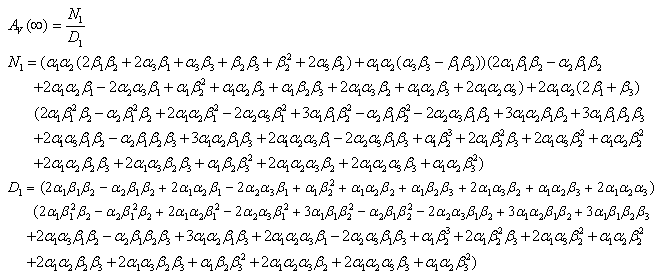 The steady-state busy period is given by
The steady-state busy period is given by  | (6) |


2.2.2. Profit Modeling
 | Figure 1. Transition diagram of the system |
The system is under corrective maintenance (repair) at failure as can be observed in states 1,3 and 4. From Fig. 1 the repairman is busy performing corrective maintenance action to the system at failure in states 1, 3 and 4. The expected profit per unit time incurred to the system in the steady-state is given by: | (7) |
2.2.3. Mean time to System Failure Modeling
It is difficult to evaluate the transient solutions, hence we follow El-said[5], Haggag[6, 13], and Wang[9], the procedure to develop the explicit expression for MTSF is to delete the rows and columns of an absorbing state in matrix  and take the transpose to produce a new matrix, say
and take the transpose to produce a new matrix, say  . The expected time to reach an absorbing state is obtained from
. The expected time to reach an absorbing state is obtained from  | (8) |
Where

3. Results
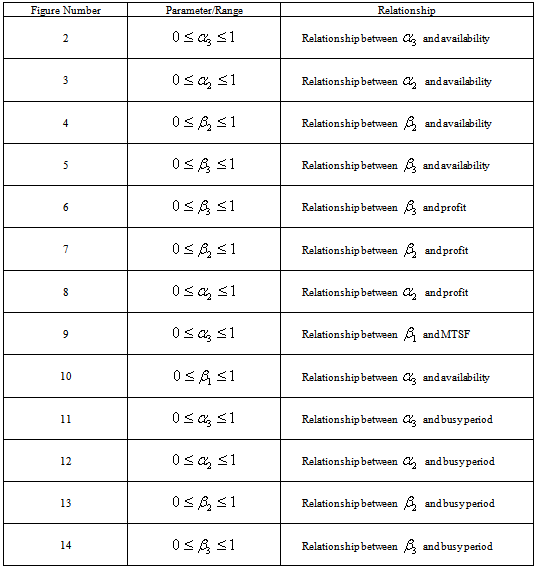
4. Discussion and Conclusions
4.1. Discussion
In this section, we numerically obtained the results for system availability and profit function for all the developed models. For the models analysis, the following set of parameters values are fixed throughout the simulations for consistency:1.  ,
, ,
, ,
, ,
, for Figures 2 and 112.
for Figures 2 and 112.  ,
, ,
, ,
, , for Figures 3 and 123.
, for Figures 3 and 123.  ,
, ,
, ,
, ,
,  for Figures 4 and 134.
for Figures 4 and 134.  ,
, ,
, ,
, , for Figures 5 and 145.
, for Figures 5 and 145.  ,
, ,
, ,
, ,
, ,
,  ,
,  ,
,  for Figures 6,7,8 and 96.
for Figures 6,7,8 and 96.  ,
, ,
,  ,
,  for Fig. 10The impact of
for Fig. 10The impact of  on system availability and busy period of repairman can be observed in Figures 2,9 and 11. From this Figures 2 and 9, it is evident that the availability and profit increases as
on system availability and busy period of repairman can be observed in Figures 2,9 and 11. From this Figures 2 and 9, it is evident that the availability and profit increases as  increases while from Fig. 11 busy period decreases with increase in
increases while from Fig. 11 busy period decreases with increase in . Similar results can be observed in Figures 3, 8 and 12 of availability, profit and busy period with respect to
. Similar results can be observed in Figures 3, 8 and 12 of availability, profit and busy period with respect to . From these Figures 3 and 8, the availability and profit increases as
. From these Figures 3 and 8, the availability and profit increases as  increase while from Fig. 12 busy period decreases with increase in
increase while from Fig. 12 busy period decreases with increase in . Results of availability, profit and busy period with respect to
. Results of availability, profit and busy period with respect to  are given in Figures 5, 6 and 13. It is evident from these Figures that as
are given in Figures 5, 6 and 13. It is evident from these Figures that as  increases, the availability and profit decreases while busy period increases. Figures 4,7 and 14 reveal the effect of
increases, the availability and profit decreases while busy period increases. Figures 4,7 and 14 reveal the effect of  on availability, profit and busy period. The results obtained in these figures reveal similar to those of Figures 5, 6 and 13 that availability and profit decreases with increase in
on availability, profit and busy period. The results obtained in these figures reveal similar to those of Figures 5, 6 and 13 that availability and profit decreases with increase in  while busy period increases with increase in
while busy period increases with increase in  . Figure 10 shows that the mean time to system failure decreases with increase in failure rate
. Figure 10 shows that the mean time to system failure decreases with increase in failure rate .
.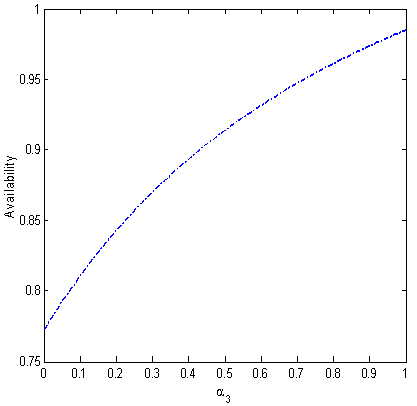 | Figure 2. Effect of  on Availability on Availability |
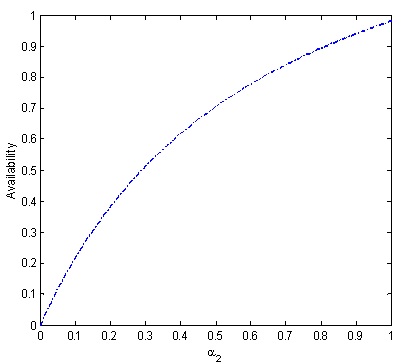 | Figure 3. Effect of  on Availability on Availability |
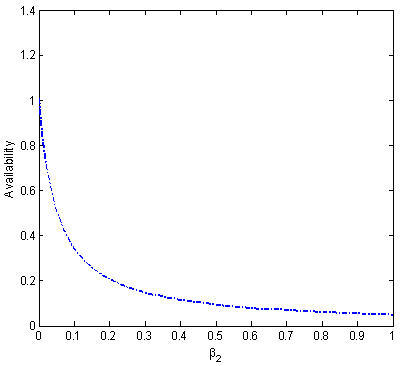 | Figure 4. Effect of  on Availability on Availability |
 | Figure 5. Effect of  on Availability on Availability |
 | Figure 6. Effect of  on Profit on Profit |
 | Figure 7. Effect of  on Profit on Profit |
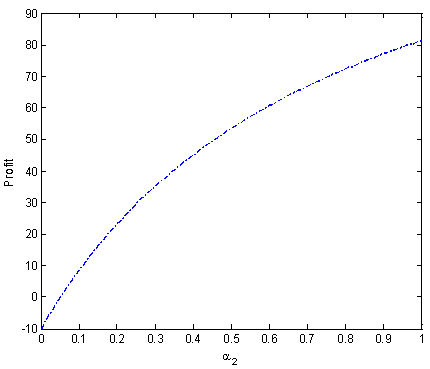 | Figure 8. Effect of  on Profit on Profit |
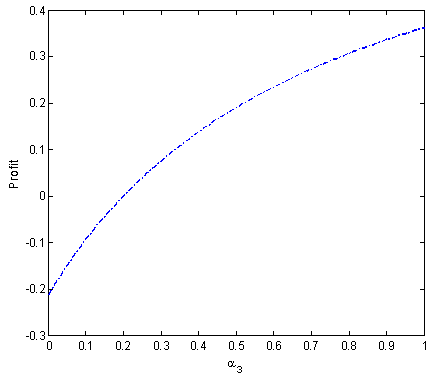 | Figure 9. Effect of  on Profit on Profit |
 | Figure 10. Effect of  on MTSF on MTSF |
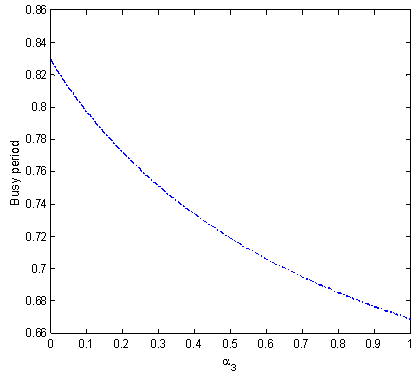 | Figure 11. Effect of  on Busy period on Busy period |
 | Figure 12. Effect of  on Busy period on Busy period |
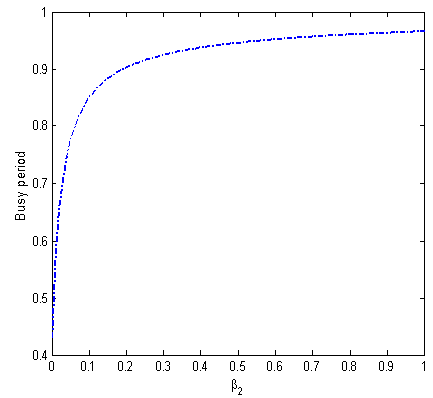 | Figure 13. Effect of  on Busy period on Busy period |
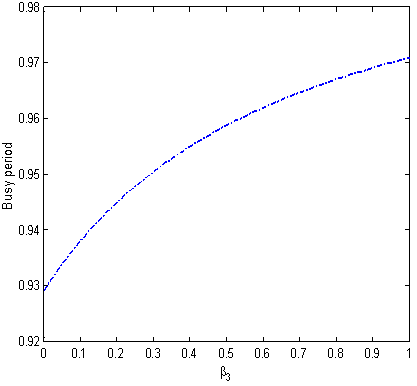 | Figure 14. Effect of  on Busy period on Busy period |
4.2. Conclusions
In this paper, we considered a system exposes to three types of failures to study the availability, generated profit and mean time to system failure. Explicit expressions of mean time to system failure, busy period, steady-state availability and profit function were derived. We performed numerical investigation to see the effect of failure and repair rates on the system availability, busy period, mean time to system failure and generated profit. It is evident from the results obtained that repair rate increase the system availability, mean time to system failure and profit generated and decreases the busy period while failure rate decreases the system availability, mean time to system failure and generated profit and increases the busy period of repairman. It is evident from that the results obtained from this paper make a tremendous effect on measure of system effectiveness studied.
ACKNOWLEDGMENTS
The authors are grateful to the anonymous reviewers and handling for their constructive comments which have helped to improve the manuscript.
References
| [1] | Hajeeh, M. Availability of a system with different repair options, International Journal of Mathematics in Operational Research, 4(1), 2012, 41-55 |
| [2] | Yusuf, I., Yusuf, B., and Bala, S.I. Availability and cost analysis of a deteriorating system, Journal of Mathematical and Computational Sciences, 3(2), 2013, 607-618 |
| [3] | El-Damcese, M.A. Analysis of warm standby systems subject to common cause failure with time varying failure and repair rates. Applied Mathematical Sciences, 3, no. 18 2009, pp 853-860 |
| [4] | Yusuf, I. and Hussaini, N. Evaluation of reliability and availability characteristics of 2-out-of-3 standby system under a perfect repair condition, American Journal of Mathematics and Statistics,2(5), 2012, 114-119. |
| [5] | Wang, K.,Hsieh, C. and Liou, C. Cost benefit analysis of series systems with cold standby components and a repairable service station. Journal of quality technology and quantitative management, 3(1), 2006, pp 77-92 |
| [6] | El-Said, K.M. Cost analysis of a system with preventive maintenance by using Kolmogorov’s forward equations method. American Journal of Applied Sciences 5(4), 2008 , pp 405-410 |
| [7] | Haggag, M.Y. Cost analysis of a system involving common cause failures and preventive |
| [8] | Bhardwaj, R.K and Chander,S. Reliability and cost benefit analysis of 2-out-of-3 redundant system with general distribution of repair and waiting time. DIAS- Technology review- An Int. J. of business and IT. 4(1), . 2007, pp 28-35 |
| [9] | Chander, S. and Bhardwai, R.K. Reliability and economic analysis of 2-out-of-3 redundant system with priority to repair. African J. of Maths and comp. sci, 2(11), 2009, pp 230-236. |
| [10] | Bhardwaj, R.K and Malik, S.C. MTSF and Cost effectiveness of 2-out-of-3 cold standby system with probability of repair and inspection. Int. J. of Eng. Sci. and Tech. 2(1), 2010, pp 5882-5889 |
| [11] | Wang, K.H. and Kuo, C.C. Cost and probabilistic analysis of series systems with mixed standby components.Applied Mathematical Modelling, 24, 2000, pp 957-967 |
| [12] | Wang,K.C, Liou, Y.C. and Pearn,W.L. Cost benefit analysis of series systems with warm standby components and general repair time. , Mathematical Methods of operation Research, 61, 2005, pp 329-343. |
| [13] | Haggag, M.Y. Cost analysis of k-out-of-n repairable system with dependent failure and standby support using Kolmogorov’s forward equations method .Journal of Mathematics and Statistics 5(4), 2009.401-407. |
| [14] | Yusuf, I. and Bala, S.I. Modeling and evaluation of MTSF of a repairable 2-out-of-4 warm standby system attended by repair machines and repairmen, Engineering Mathematics Letters, 2(2), 2013, pp 81-89 |
| [15] | Yusuf, I. and Hussaini, N. Stochastic modeling of repairable redundant system comprising one big unit and three small dissimilar units, American Journal of Computational and Applied Mathematics, 2(4), 2012, 174-188 |

 occurred to system when new, at this junction an imperfect repair
occurred to system when new, at this junction an imperfect repair  is done to the system. From there the system continue to operate in a reduced capacity until type II a non repairable occurred. The entire system is replaced (
is done to the system. From there the system continue to operate in a reduced capacity until type II a non repairable occurred. The entire system is replaced ( ) at the occurrence of type II failure
) at the occurrence of type II failure . The system can also transit to partial type III failure state with rate
. The system can also transit to partial type III failure state with rate  and the system is perfectly repaired (
and the system is perfectly repaired ( ).
). : The System’s initial (new) state
: The System’s initial (new) state : The System is under imperfect repair
: The System is under imperfect repair  : The System is working in a reduced capacity
: The System is working in a reduced capacity  : The System is under non repairable failure
: The System is under non repairable failure  : The System is under partial failure
: The System is under partial failure : Imperfect repair rate
: Imperfect repair rate : Replacement rate
: Replacement rate : Perfect repair rate
: Perfect repair rate : Type I failure rate
: Type I failure rate : Type II failure rate
: Type II failure rate : Type III failure rate
: Type III failure rate be the probability row vector at time
be the probability row vector at time , then the initial conditions for this problem are as follows:
, then the initial conditions for this problem are as follows:
 we obtain the following system of differential equations:
we obtain the following system of differential equations: 






 The system of differential equations in (1) for the system above can be expressed in matrix form as:
The system of differential equations in (1) for the system above can be expressed in matrix form as: Let
Let  be the time to failure of the system. The steady-state availability is given by
be the time to failure of the system. The steady-state availability is given by 

 using the normalizing condition
using the normalizing condition

 The steady-state busy period is given by
The steady-state busy period is given by 




 and take the transpose to produce a new matrix, say
and take the transpose to produce a new matrix, say  . The expected time to reach an absorbing state is obtained from
. The expected time to reach an absorbing state is obtained from 



 ,
, ,
, ,
, ,
, for Figures 2 and 112.
for Figures 2 and 112.  ,
, ,
, ,
, , for Figures 3 and 123.
, for Figures 3 and 123.  ,
, ,
, ,
, ,
,  for Figures 4 and 134.
for Figures 4 and 134.  ,
, ,
, ,
, , for Figures 5 and 145.
, for Figures 5 and 145.  ,
, ,
, ,
, ,
, ,
,  ,
,  ,
,  for Figures 6,7,8 and 96.
for Figures 6,7,8 and 96.  ,
, ,
,  ,
,  for Fig. 10The impact of
for Fig. 10The impact of  on system availability and busy period of repairman can be observed in Figures 2,9 and 11. From this Figures 2 and 9, it is evident that the availability and profit increases as
on system availability and busy period of repairman can be observed in Figures 2,9 and 11. From this Figures 2 and 9, it is evident that the availability and profit increases as  increases while from Fig. 11 busy period decreases with increase in
increases while from Fig. 11 busy period decreases with increase in . Similar results can be observed in Figures 3, 8 and 12 of availability, profit and busy period with respect to
. Similar results can be observed in Figures 3, 8 and 12 of availability, profit and busy period with respect to . From these Figures 3 and 8, the availability and profit increases as
. From these Figures 3 and 8, the availability and profit increases as  increase while from Fig. 12 busy period decreases with increase in
increase while from Fig. 12 busy period decreases with increase in . Results of availability, profit and busy period with respect to
. Results of availability, profit and busy period with respect to  are given in Figures 5, 6 and 13. It is evident from these Figures that as
are given in Figures 5, 6 and 13. It is evident from these Figures that as  increases, the availability and profit decreases while busy period increases. Figures 4,7 and 14 reveal the effect of
increases, the availability and profit decreases while busy period increases. Figures 4,7 and 14 reveal the effect of  on availability, profit and busy period. The results obtained in these figures reveal similar to those of Figures 5, 6 and 13 that availability and profit decreases with increase in
on availability, profit and busy period. The results obtained in these figures reveal similar to those of Figures 5, 6 and 13 that availability and profit decreases with increase in  while busy period increases with increase in
while busy period increases with increase in  . Figure 10 shows that the mean time to system failure decreases with increase in failure rate
. Figure 10 shows that the mean time to system failure decreases with increase in failure rate .
.
 on Availability
on Availability
 on Availability
on Availability
 on Availability
on Availability
 on Availability
on Availability
 on Profit
on Profit
 on Profit
on Profit
 on Profit
on Profit
 on Profit
on Profit
 on MTSF
on MTSF
 on Busy period
on Busy period
 on Busy period
on Busy period
 on Busy period
on Busy period
 on Busy period
on Busy period Abstract
Abstract Reference
Reference Full-Text PDF
Full-Text PDF Full-text HTML
Full-text HTML